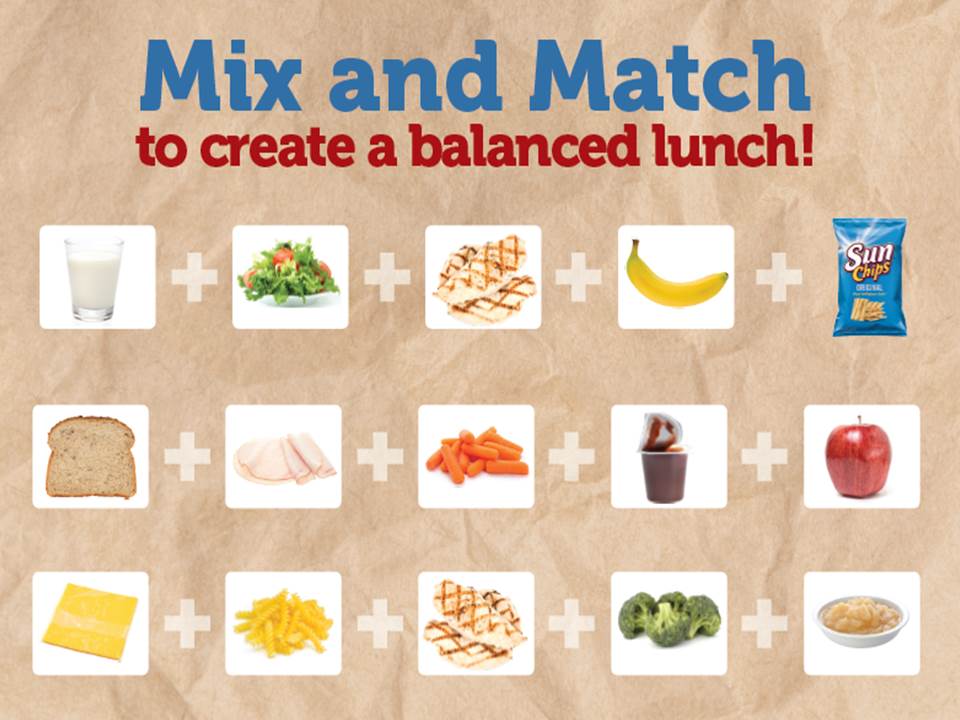
by Ricki McWilliams | Sep 6, 2014
 It’s time to start getting backpacks ready, lunches packed and kids off to school. Back to school time is the perfect time to start packing a healthier lunchbox. Packing your child’s lunch may contribute to the difficulties of getting out the door in the morning but it does not have to. You know your child better than anyone, their likes and dislikes, so go with what you know.
It’s time to start getting backpacks ready, lunches packed and kids off to school. Back to school time is the perfect time to start packing a healthier lunchbox. Packing your child’s lunch may contribute to the difficulties of getting out the door in the morning but it does not have to. You know your child better than anyone, their likes and dislikes, so go with what you know.
The first step to packing a lunch is to determine how much food is enough for your child. You will know you did not pack enough when they come home and tell you they ate all their food and are still hungry. Likewise, if you pack too much, you will know by seeing uneaten or half-eaten items in their lunch box at the end of the day. Start by packing between 3 and 6 items. They will have enough variety in their lunch box to sustain them throughout the school day without too much waste. MyPlate.gov is a great resource for building a balanced meal (protein, vegetable, fruit, grain, dairy).
Secondly, pack as much as you can the night before. This will decrease morning stress. Cut up fruits and vegetables and store in an airtight container in the refrigerator. Cut up fresh ingredients for sandwiches, if required. Make up cracker or dried fruit packs. Wrap up home-baked treats and place in the lunch box.
Lastly, keep in mind this food safety tip: Include gel ice packs to keep refrigerated food cold. Refrigerated food shouldn’t be above 40 degrees for more than 4 hours due to increased bacterial growth causing possible illness.
Lunchbox Meal Ideas:
1.) Wheat crackers, cheese cubes, deli meat, strawberries/blueberries, snap peas (with their favorite dipping sauce*)
2.) Mini quiche, carrots, celery with peanut butter and raisins, whole fruit (pear, orange, banana)
*Want something to dip kid-friendly veggies in besides ranch? Try low-fat Greek yogurt, hummus, or this cottage cheese veggie dip:
1/2 cup low-fat cottage cheese
1/4 teaspoon lemon pepper
Enjoy with baby carrots, snow/snap peas, bell pepper strips
Snack Ideas:
1.) Whole wheat pita cut into wedges with 2 tablespoons hummus for dip
2.) Trail mix: mix 20 almonds, miniature box of raisins, and ¼ cup sunflower seeds
For additional information on creating nutritious meals, contact your local Extension office.
by Melanie Taylor | Jun 2, 2014

Summer camp teaches children independence and leadership skills.
Summer is here and summer camp is on the horizon. Maybe this is your child’s first time to an overnight camp or they are “old pros” at this thing called camp. Many parents and children will have camp anxieties, but here are some things you can do to prepare your camper and yourself for camp.
Campers:
• Plan several sleepovers before the week of camp arrives. Resist the urge to pack their bags for them or to check on them while there. If they have a cell phone, have them leave it at home. This is a good way to practice not having direct or constant contact.
• Encourage them to write a letter to someone (maybe you) while at camp. You will be so excited when you receive a letter from camp! Be sure to include envelopes, addresses, stamps, paper, and a pen in their luggage.
• Gear up physically. If you have purchased your camper new tennis shoes, have them break them in with a few long walks so the blisters don’t happen at camp.
• Especially for teenagers, have them take a mini-vacation from their electronic devices – a couple of hours or a weekend.
• Have them write a statement for their social media pages. “Peace out Facebook, I will be at camp for the next week. Check in with you when I get back” or something similar.
• Have them write down their goals for camp so they can mentally prepare themselves for what they hope to do and see.
• Make a homesick plan:
1. Homesickness isn’t entirely bad. It’s great to love your home. It’s sometimes part of the process and it’s a confidence-booster when a camper gets through it.
2. Make a “happy place” plan and write it down. This is an amazing opportunity to learn a life skill. Today’s youth go to technology to escape and studies show this increases their stress. Some ideas include: taking 10 deep breaths, traveling to a “happy place” in your mind, packing a certain stuffed animal, or tossing a football. Children are capable of this independence.
3. Your plan should NOT be, “Give it a couple of days and if you don’t like it, we will come get you.” This will set them up to give it a couple of days and knock the confidence right out of them.
4. Let your camper know what to expect with correspondence. You don’t need to write every day but let them know what to expect.
Parents:
• You are giving your child an incredible gift. I cannot promise you they will not lose some socks, they will love every meal or activity, and they will adore every staff member. But you are preparing them for college and beyond; you are giving them the freedom to gain confidence, independence, and leadership skills; and you are instilling in them that they can do it.
• What do YOU want to do during their time at camp? Plan a vacation for a later time, organize the house, or enjoy one-on-one time with your other children or some “date nights” with your spouse or friends.
• If you have apprehensions, work to resolve them. If you are worried your camper is not going to know anyone, set up a pre-camp get-together. If you are worried about your camper’s medical needs, become friendly with the camp staff. If you are anxious about their food allergies, talk to the camp’s director. Make a camper-sick plan for yourself. Make sure there is only excitement and optimism coming from you; share your anxiety with another adult.
• Pack self-addressed stamped envelopes in their luggage.
• Whether they are flying or driving, hold off on crying your eyes out until they cannot see you. Take a deep breath, trust, and remind yourself you are giving them an awesome gift.
And just what is this gift everyone is talking about? At camp, they will be part of a community all their own. They will become emotionally attached to handmade rope bracelets on their wrist, and have a song for any occasion on cue, and maybe even forget they need to shower, and think sunscreen is just a normal daily moisturizing technique. They will learn to do things on their own and they’ll learn to rely on others. They will learn how to survive on their own for a week or two and they’ll learn how to help each other through it.
They may even grow up on summers away from TV and forget Facebook exists. They will relish the joy of sleeping in cabins, swatting mosquitoes at campfire, and swimming every day. They will savor the feeling of pushing water behind them with a paddle and the whoosh of air behind the tail of an arrow as they fire. They’ll forget about appearances, relish tan lines, and recognize the beauty of a smile over anything else.
So send your kids to camp. Send them so they’ll learn to set tables and make beds and wake early. Send them so they’ll know how to be a leader, paddle a kayak, weave a bracelet, and sing as loud as they can. Send your kids to camp so they’ll learn to love themselves and learn to love others. Send your kids to camp because they’ll realize who they are – or who they want to be. And, prepare yourselves for a year of camp stories and for a flurry of songs. Prepare to learn names of kids you’ve never met. And for your kids to have a need for sunshine, campfires, and companionship. They will be forever grateful for your awesome gift of summer camp.
Source:
American Camping Association, Inc. (http://www.acacamps.org)
by Monica Brinkley | Jun 2, 2014
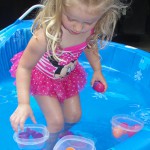
Simple sorting games teach pre-math skills to young children.
Children are born curious and are constantly learning about the world around them. Children learn basic math skills through daily activities and interaction. They practice basic math skills as they notice differences between things, how events happen the same way every time, and how they can make events happen. Many parents push their children to count to ten, but teaching children to count involves more than reciting. It involves helping children understand the meaning of numbers.
Children will learn the meaning of numbers when they are developmentally ready. They might know the numbers in sequence, but are not able to use them to count. In others words, they may count to three and move four objects. Begin counting with children around the age of two to three. This helps children begin to move towards matching one thing at a time with the numbers as they say it.
Three- to four-year-old children are still learning to understand quantity. They usually can count to five and are growing in their understanding of what numbers really mean. By ages four to six, they are counting with meaning, usually matching the numbers one to ten with ten items.
Counting can be fun with your help. There are many fun activities you can do with your children to assist in learning the meaning of counting. Count socks as you sort them; count the juice boxes in the refrigerator or the cars going by. The more experience they are given, the more they will learn the meaning of numbers. Giving your child experience regularly will help them in their understanding of numbers.
To help your child get ready for math, give him/her opportunities to think about patterns and to sort things. Use items you find around the house or outside. Lay out a pattern with items such as a leaf, stick and stone and repeat the pattern. Ask your child to make the same pattern. This is a very simple but fun way to introduce math concepts. Sorting can be done easily when doing household chores. Sorting towels by color, putting small towels in this spot on the shelf and large towels in that spot are just a couple of sorting ideas.
Learning about shapes, space, and measurement are also pre-math skills you can help preschool children develop. Talk about shapes as you are walking or riding down the road. Examples: see the round stop light; this sandwich is square until we cut it in half, it then becomes a triangle. Inches, feet, and other units of measurement don’t make much sense to a young child. However, you can teach a child to measure with objects like a shoe. Have them see how long a rug is with a shoe. Then work up to giving them a ruler to work on measurement problems.
Teaching pre-math skills is easy. Recognize the curiosity in young children and use this as an opportunity to teach in a fun way.
Source: Penn State Extension; Better Kid Care, Math for Every Age.
by Ginny Hinton | May 12, 2014
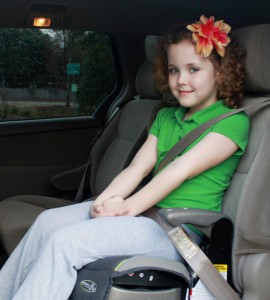
New bill would require booster seats for children four years old through age five.
For several years, Florida has been the most dangerous state for children between the ages of 4 and 10 traveling in vehicles. Florida is currently one of only two states in the nation that lacks a booster seat bill for older children – and the only state that allows 4-year-olds to ride in an adult seatbelt.
Booster seats are needed for the simple reason that seat belts are designed to fit adults – specifically the “average” adult male. When a child under age 8 (on average) or under 4’ 9” tall and 80 pounds sits in an adult seatbelt, the lap belt tends to ride up onto his or her stomach. In a crash the belt tightens to keep the child from being ejected. It cuts through the soft stomach and the first bone to stop it is the spinal cord. This is known as “seat belt syndrome”. It can cause severe injuries including internal bleeding and even paralysis. A booster seat “boosts” the child up about six inches so the belt fits below the stomach and can restrain the child properly without causing injury. Using a booster seat reduces your child’s risk of injury by about 60%.
In Florida, some kids are about to get a safety “boost”. The Florida House and Senate just passed the revisions to Florida Statute 316.613 with Bill 225. If signed by Governor Scott, the new regulations will take effect on January 1, 2015. The new law will require children aged 4 through 5 years old to travel in a car seat or booster, NOT an adult seat belt. Unpaid drivers who are not in the child’s immediate family, children being transported for medical emergencies and children with a medical condition necessitating an exception are exempt from the law.
While this law by no means provides adequate protection for Florida’s older children, it is at least a step in the right direction. By a slim margin, Florida will no longer be the most unsafe state in the nation for child passengers.
by Heidi Copeland | May 12, 2014
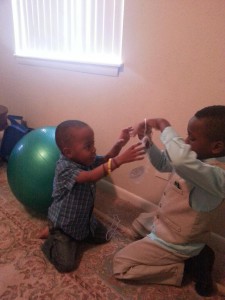 Not much has changed since the American Academy of Pediatrics released their clinical report in 2006 about the importance of play in promoting healthy child development. In fact, play is so important to optimal child development that in 1989 the United Nations High Commission for Human Rights recognized play as a right of every child. Seriously! Play is essential to child development. Play contributes to the cognitive, physical, social, and emotional well-being of children and youth.
Not much has changed since the American Academy of Pediatrics released their clinical report in 2006 about the importance of play in promoting healthy child development. In fact, play is so important to optimal child development that in 1989 the United Nations High Commission for Human Rights recognized play as a right of every child. Seriously! Play is essential to child development. Play contributes to the cognitive, physical, social, and emotional well-being of children and youth.
Play is a child’s work. Play is how a child learns best. Play is the most effective way to involve every aspect of child development – cognitive, physical, social, and emotional well-being of children and youth. Play allows children to engage and interact in the world around them. Play enhances children’s learning readiness, learning behaviors, and problem-solving skills. Play is a simple joy that we should all remember as a cherished part of childhood.
Nonetheless, children and youth are experiencing decreased amount of child-directed, free unstructured play.
As another school year comes to an ends start thinking about the importance of this free, unstructured, child-driven play this summer. Are you allowing enough time in each day for your child to be running, bike riding, bouncing balls, climbing, and gazing up at the clouds actively using their imagination? Or are they going to be sitting and passively entertained through the screens of a television, computer, video game or even phone?
Think about it, play is a tried-and-true part of child rearing. Play also offers a perfect opportunity for parents to get fully involved with their children and youth.
Don’t buy into the next thingamajig that promises to make your child, better, brighter, happier, or more successful. Buy into the tried, trusted and traditional methods of play! The only thing you have to invest is quality time with your children and youth.
As the clinical report also mentions, adults who share unscheduled, spontaneous playtime with their children are being wonderfully supportive, nurturing and productive. What do you have to lose? Make some time to play today!
by Monica Brinkley | Sep 24, 2013
Normal
0
false
false
false
EN-US
X-NONE
X-NONE
/* Style Definitions */
table.MsoNormalTable
{mso-style-name:”Table Normal”;
mso-tstyle-rowband-size:0;
mso-tstyle-colband-size:0;
mso-style-noshow:yes;
mso-style-priority:99;
mso-style-parent:””;
mso-padding-alt:0in 5.4pt 0in 5.4pt;
mso-para-margin:0in;
mso-para-margin-bottom:.0001pt;
mso-pagination:widow-orphan;
font-size:11.0pt;
font-family:”Calibri”,”sans-serif”;
mso-ascii-font-family:Calibri;
mso-ascii-theme-font:minor-latin;
mso-hansi-font-family:Calibri;
mso-hansi-theme-font:minor-latin;}
Some children dread the thought of doing homework. They may leave an assignment for the last minute or refuse to do it all together. Many parents handle this by trying to force their children to do their homework. However, getting into a power struggle with your child is not effective. By having clear rules and expectations, you can create a positive situation for both you and your child.
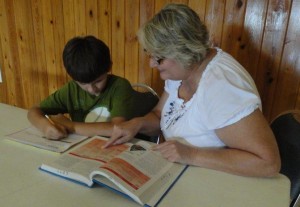
Help children develop good study habits
Meaningful homework can help students do better in school, especially as they get into the upper grades. Homework teaches children responsibility, as well as how to follow directions, manage time, begin and complete a task, work on their own, and practice what they’re learning in class. However, most children would much rather be playing or doing other things than homework. Many parents and children struggle over when, where, and how homework will be done.
At times, parents may feel that it would be easier just to do the work for their children. However, the National Parent and Teacher Association advises parents to let children do homework themselves. You may need to sit with elementary-school-age children and walk them through the process of how to study, help them organize the materials they need, and make sure they’ve completed all their tasks. As you do this, you are laying the foundation for good study habits.
Parents can offer to help check homework, but helping is very different from taking over. You also can reinforce good habits by helping your child find a regular place to work and a regular time of day to do homework. Instead of asking if your child has homework every night, always assume that there is homework, reading, or studying of some kind to be done.
Here are some tips on things you can do to help your children with homework:
- Have a set time for your child to do homework.
- Get the whole family involved by setting a regular family quiet time for working. Provide your child with a comfortable and well-lit place where they can do homework, such as a desk or a kitchen table with a chair. Minimize distractions by turning off the TV and making video games off-limits during quiet time.
- Make sure your child has pens, pencils, notebook paper, and any other supplies. Know where to direct your child to get information they may need, such as a school, a website, other children in the class, or a teacher’s help before or after school.
- Think of yourself as a coach to your children, providing assistance on what to do next if they get stuck, checking over their work when they are finished, or even helping them practice testing themselves on new skills. Showing interest in their work and encouraging their efforts can be a boost for your children and help them find greater success in school.
- Avoid constantly nagging or lecturing your child to do homework. If your child is continuously frustrated by or unable to complete assignments, visit your child’s teacher. Discuss ideas to work out possible strategies to help your child succeed.
For further information, go to EDIS.IFAS.UFL.EDU.
Sources: FAR1718 Helping Children with Homework, Heidi Liss Radunovich; FCS2203 Parenting During the Elementary School Years, Part 2: Discipline, Millie Ferrer-Chancy, Ingrid Rivera and Anne M. Fugate.

 It’s time to start getting backpacks ready, lunches packed and kids off to school. Back to school time is the perfect time to start packing a healthier lunchbox. Packing your child’s lunch may contribute to the difficulties of getting out the door in the morning but it does not have to. You know your child better than anyone, their likes and dislikes, so go with what you know.
It’s time to start getting backpacks ready, lunches packed and kids off to school. Back to school time is the perfect time to start packing a healthier lunchbox. Packing your child’s lunch may contribute to the difficulties of getting out the door in the morning but it does not have to. You know your child better than anyone, their likes and dislikes, so go with what you know.




